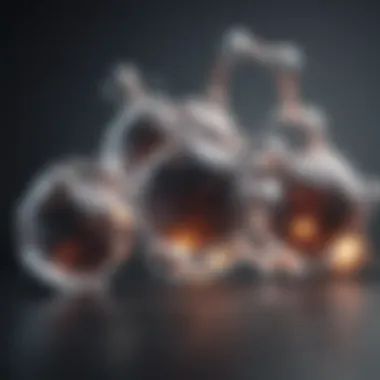Hydrogen Peroxide: Efficacy in Teeth Whitening


Intro
Teeth whitening is a sought-after cosmetic procedure, with many individuals looking for effective methods to achieve a brighter smile. The popularity of home whitening solutions is growing rapidly, in part due to their accessibility and affordability. Among these solutions, hydrogen peroxide has gained significant attention as a potential agent for teeth whitening.
The efficacy of hydrogen peroxide as a whitening agent lies in its chemical structure, which breaks down into water and oxygen upon application. The oxygen then interacts with the organic compounds causing discoloration in teeth. However, the concentration and application method are pivotal in determining both effectiveness and safety. This article aims to dissect the multifaceted aspects of using hydrogen peroxide for teeth whitening, providing a well-rounded understanding of its role in dental aesthetics.
Research Overview
Summary of Key Findings
Hydrogen peroxide effectively whitens teeth through oxidative processes. Research indicates that various concentrations yield different results. Lower concentrations are less effective but may decrease the risk of side effects, while higher concentrations show more notable results but could lead to increased sensitivity in some users.
Key points drawn from various studies include:
- Concentration Variability: Products range from 3% to 35% hydrogen peroxide.
- Effectiveness Comparison: Hydrogen peroxide can rival traditional whitening methods employed by professionals.
- Safety Assessments: Concerns regarding gum irritation and enamel erosion persist but can be mitigated with proper usage guidelines.
Relevance to Current Scientific Discussions
The examination of hydrogen peroxide in teeth whitening intersects with ongoing research on dental health and cosmetic enhancements. The shift towards at-home solutions has prompted studies evaluating both the scientific validity and consumer safety associated with these products. These findings contribute to the broader conversation around regulatory standards in cosmetic dentistry and the importance of evidence-based practice for safety and efficacy.
Methodology
Research Design and Approach
A thorough literature review was conducted to analyze existing research on hydrogen peroxide's efficacy in teeth whitening. This approach ensured a comprehensive understanding of the various concentrations and their respective outcomes on dental aesthetics. Data drawn from clinical trials and consumer surveys formed the basis of the analysis, ensuring a well-rounded assessment of the product's effectiveness.
Data Collection and Analysis Techniques
Data were collected from various credible sources including dental journals, academic publications, and consumer reports.
- Quantitative Analysis: Measured changes in tooth color using standard dental shades.
- Qualitative Assessment: Reviewed consumer experiences and perceptions regarding safety and effectiveness.
Prologue to Teeth Whitening
Teeth whitening has gained extraordinary momentum in cosmetic dentistry. Its significance extends beyond mere aesthetics; it resonates with the growing societal obsession for bright, white smiles. An appealing smile can boost self-confidence, enhance personal and professional interactions, and even influence perceptions in social contexts. As a result, understanding the mechanisms behind teeth whitening, especially using agents like hydrogen peroxide, becomes crucial for anyone considering cosmetic dental options.
Consumers often seek out information about the efficacy and safety of different whitening methods. This initiative can lead to improved choices that align with both their needs annd expectations. The increasing availability of whitening products, coupled with numerous online discussions, has made knowledge about teeth whitening more accessible. Therefore, an exploration of this topic is ripe for examination.
As various whitening methods flood the market, distinctions among them could have dramatic effects on outcomes. This article puts a spotlight on hydrogen peroxide, which is known for its bleaching properties, to understand its effectiveness and safety as a teeth whitening option. It aims to synthesize scientific insights and popular opinion, catering to both professional and lay audiences alike.
Understanding Hydrogen Peroxide
Hydrogen peroxide is a compound that plays a significant role in the context of teeth whitening. Its efficacy lies not only in its chemical composition but also in its mechanism of action. As many individuals seek brighter smiles, understanding the properties of hydrogen peroxide becomes essential. This section aims to clarify its relevance in dental aesthetics and shed light on its functionalities and benefits.
Chemical Composition
Hydrogen peroxide consists of two hydrogen atoms and two oxygen atoms, resulting in a simple formula, H₂O₂. This molecular structure can easily decompose into water (H₂O) and oxygen (O₂), a process that contributes to its effectiveness as a whitening agent. The stability of hydrogen peroxide is influenced by its concentration and the presence of light. Typically, commercially available hydrogen peroxide for dental use varies in concentration, ranging from low levels around 3% to higher concentrations of up to 35% or more.
In addition, the presence of stabilizers in formulations can help maintain its efficacy and extend shelf life. Consumers' understanding of these compositions is vital not only for application but also for safe usage.
Mechanism of Action
The whitening action of hydrogen peroxide occurs primarily through oxidation. When applied to tooth enamel, the hydrogen peroxide penetrates the outer layer and breaks down the chromogens—pigments causing discoloration—into smaller, less pigmented molecules. This oxidation reaction alters the structure of these pigments, effectively lightening the tooth's color.
The speed and efficiency of this process depend on several factors, such as concentration, application time, and the method of application. Higher concentrations generally yield quicker results, but they also increase the risk of potential adverse effects.
"Understanding the balance between efficacy and safety is crucial when using hydrogen peroxide for teeth whitening."


Moreover, the effectiveness of hydrogen peroxide can be enhanced by utilizing it in combination with light or heat sources, often seen in professional treatments. This synergistic effect can lead to improved outcomes, making it a preferred choice in many dental offices.
By becoming familiar with the chemical aspects and operational mechanisms of hydrogen peroxide, individuals can make informed decisions regarding its use in teeth whitening. This understanding is part of the larger dialogue about consumer safety and product efficacy in a marketplace that is swiftly evolving.
Concentration Variants
The concentration of hydrogen peroxide used in teeth whitening is a key factor that influences both efficacy and safety. Variants in concentration can determine the potency of the whitening effect, while also presenting different risks for oral health. Understanding these concentrations allows consumers and professionals to make informed decisions about which method to employ for best results.
Low Concentration Applications
Low concentration hydrogen peroxide solutions typically range from 3% to 10%. These lower concentrations are often found in over-the-counter whitening products, such as whitening strips and gels. They are designed for safe, at-home use, reducing the likelihood of adverse effects.
The advantage of low concentration applications lies in their comparatively gentle approach. For example, a 3% hydrogen peroxide solution is commonly incorporated into many daily-use whitening products, offering gradual results with minimized risks of gum irritation or tooth sensitivity. This approach is especially suitable for individuals with sensitive teeth or those unaccustomed to professional treatments.
However, the effectiveness of low concentration products can vary. Users should manage their expectations, as significant whitening results may take more time and repeated application. Encouraging adherence to a consistent routine can help achieve desired outcomes without causing harm to dental health.
High Concentration Applications
High concentration hydrogen peroxide solutions are often over 10%, reaching up to 40% in some professional treatments. These stronger formulations are typically used in dental offices where trained professionals supervise their application. High concentrations yield quicker, more noticeable results, making them appealing for individuals seeking immediate improvements for special occasions or personal preferences.
However, high concentration products also carry increased risks. Possible side effects include greater tooth sensitivity and potential damage to soft tissues in the mouth. Professionals usually conduct protective measures before applying high-strength solutions, such as using barrier gels to shield gums.
A comprehensive understanding of the differences between low and high concentration applications helps amplify the discussion about hydrogen peroxide's role in teeth whitening. Continuing education about concentration safety and effectiveness is crucial as it enables informed choices for anyone interested in enhancing their oral aesthetics.
Methods of Application
Understanding the methods of application for hydrogen peroxide in teeth whitening is critical. This section elucidates two main approaches: DIY techniques and professional treatments. Each method offers distinct advantages and considerations that are essential for achieving optimal whitening results while minimizing risks associated with misuse.
DIY Whitening Techniques
DIY whitening techniques utilizing hydrogen peroxide are widely popular due to their accessibility and cost-effectiveness. These methods often involve using solutions with varying concentrations of hydrogen peroxide, commonly found in consumer products like toothpaste and mouth rinses. Simple home remedies can include the following:
- Mouth Rinses: Diluting hydrogen peroxide with water to create a rinse can help in whitening. Users must ensure it is not too concentrated to avoid irritation.
- Whitening Strips: Some products incorporate hydrogen peroxide as an active ingredient. Results can vary, but they tend to offer a user-friendly approach.
- Baking Soda Mixes: Combining baking soda with hydrogen peroxide creates a paste that many find effective.
Using DIY techniques may appeal to those seeking convenience and cost savings. However, there are significant considerations. Overuse or incorrect dilution can lead to enamel erosion or gum irritation. Therefore, it is advised to perform a patch test on a small tooth surface before regular use. The importance of moderation cannot be overstated in preventing adverse effects.
Professional Treatments
Professional treatments administered by dental professionals present a more controlled environment for whitening with hydrogen peroxide. These treatments typically use higher concentrations of hydrogen peroxide and often incorporate advanced techniques. Key benefits include:
- Effective Results: Professional services tend to yield more immediate and noticeable results due to the higher concentration of active ingredient.
- Supervised Application: Professionals can monitor the process closely, reducing the likelihood of side effects.
- Customization: Dentists can tailor treatments based on individual needs, taking into account the patient's dental history and aesthetics goals.
Moreover, the methods can include:
- In-Office Treatments: These involve applying high-concentration hydrogen peroxide directly to the teeth and sometimes using light to enhance the process.
- Take-Home Kits: Professionals may also provide custom-fit trays filled with hydrogen peroxide gel for at-home use which aligns professional oversight with convenience.
In summary, both DIY and professional applications of hydrogen peroxide in teeth whitening play vital roles. While DIY options can be appealing, maintaining safety and effectiveness is essential. Meanwhile, professional treatments offer significant advantages in supervision and tailored results. Making an informed choice about the method is crucial for achieving the desired aesthetic outcomes while safeguarding oral health.
"Effective teeth whitening requires understanding both the benefits and the limitations of hydrogen peroxide's various application methods."
Choosing the right method can deeply influence the results, making knowledge in this area invaluable.
Safety Considerations
The usage of hydrogen peroxide for teeth whitening has surged in popularity among consumers. However, understanding its safety considerations is paramount. Safety not only affects the efficacy of the treatment but also ensures the long-term health of one’s teeth and gums. Individuals should be well-informed about potential risks and guidelines to prevent adverse effects.
Potential Side Effects


Hydrogen peroxide, while effective, can present side effects that warrant attention. Some common side effects include:
- Tooth Sensitivity: Users may experience increased sensitivity, particularly with higher concentrations. This can cause discomfort during or after treatment.
- Gum Irritation: Direct contact with hydrogen peroxide can irritate the gums. This irritation might manifest as redness or discomfort.
- Enamel Erosion: Prolonged or excessive use might harm the enamel, possibly leading to long-term dental issues.
- Taste Alterations: Some individuals report changes in taste perception during and after the usage of hydrogen peroxide products.
It’s essential for users to recognize these side effects and to monitor their reactions to the treatment closely. If serious irritation or sensitivity occurs, discontinuing use and consulting a dental professional is advised.
Safe Usage Guidelines
To mitigate risks associated with hydrogen peroxide use, following specific guidelines is significant. Here are some safe usage principles:
- Consult a Professional: Before starting any whitening regimen, especially with hydrogen peroxide, consult a dentist. They can provide advice tailored to individual oral health needs.
- Select the Right Concentration: Products containing 3% hydrogen peroxide are commonly recommended for at-home use. Higher concentrations should generally only be used under professional supervision.
- Limit Application Frequency: Avoid excessive use. A limit of one to two treatments per week is often adequate for most individuals, allowing for recovery between applications.
- Follow Instructions: Adhere closely to product instructions. Ensure proper dilution if using concentrated forms and follow timing recommendations to avoid damage.
- Monitor Oral Health: Pay attention to any adverse reactions during the treatment. If sensitivity or irritation occurs, immediate cessation and dental consultation are wise.
In essence, while hydrogen peroxide can be an effective whitening agent, its safe application is crucial to maintaining dental health. Being proactive about safety can ensure a positive experience and prevent complications.
Comparative Effectiveness
In assessing the role of hydrogen peroxide in teeth whitening, examining its comparative effectiveness against other whitening agents is crucial. The goal of this section is to discern how hydrogen peroxide stands up to both traditional and innovative whitening solutions available on the market today.
Hydrogen peroxide is a well-known bleaching agent. It has gained significant traction due to its effectiveness and relative accessibility. However, it is essential to consider various other whitening agents like carbamide peroxide and natural alternatives such as baking soda and activated charcoal. Each agent brings unique properties and results.
Hydrogen Peroxide vs. Other Agents
When comparing hydrogen peroxide to other whitening agents, a few factors can be highlighted.
- Efficacy: Hydrogen peroxide tends to provide quicker results. Many whitening products with hydrogen peroxide show visible whitening in a shorter time frame than those using alternatives like carbamide peroxide, which operates slower due to its different chemical structure.
- Concentration Levels: The effectiveness of hydrogen peroxide varies with concentration. Higher concentrations are typically more effective but come with increased risk of side effects. Other agents, like baking soda, may have milder effects, which may appeal to those who prioritize safety over swift results.
- Application Methods: Hydrogen peroxide is versatile and can be found in various forms such as gels, strips, and mouth rinses. Some alternatives might not have the same packaging benefits, limiting how easily consumers can apply them.
- Cost-Effectiveness: The affordability of hydrogen peroxide products is an advantage. Many products that contain hydrogen peroxide are less expensive than some professional treatments, making them a favorite among consumers.
Though effectiveness is critical, the potential side effects associated with hydrogen peroxide also generate much discussion. While side effects can occur with any whitening method, those involving hydrogen peroxide often include tooth sensitivity and gum irritation, particularly at higher concentrations. It is crucial for consumers to weigh out these factors and determine what best aligns with their needs.
Consumer Preferences
Consumer preferences regarding teeth whitening often reflect prevailing trends and personal priorities. Hydrogen peroxide products often lead the market in popularity. Consumer research suggests that marketing and the influence of social media play a substantial role in shaping perceptions and behaviors.
- Perceived Effectiveness: Many individuals view hydrogen peroxide as a credible solution, often due to its extensive presence in dental care discussions.
- Recommendations from Influencers: Social media plays a powerful role, with many beauty influencers endorsing certain whitening products. This can significantly sway consumer decisions, often leading audiences to prefer products with hydrogen peroxide, as influencers validate their effectiveness.
- Simplicity and Convenience: Consumers frequently seek easy-to-use options for teeth whitening. Hydrogen peroxide products that can be used at home offer convenience over professional treatments that require more time and financial investment.
- Feedback and Reviews: Online reviews also impact consumer decisions. Products that showcase positive feedback for hydrogen peroxide tend to attract more buyers.
In summary, the comparative effectiveness of hydrogen peroxide as a teeth whitening agent highlights its efficiency and consumer preference. When combined with effective marketing and social media presence, it can dominate the market. As the demand for dental aesthetics continues to surge, understanding these dynamics is becoming increasingly important.
Consumer Perception and Trends
Consumer perception plays a critical role in determining the efficacy of hydrogen peroxide as a teeth whitening solution. As the market for dental aesthetics continues to grow, understanding how consumers view these products can offer insight into their usage and overall acceptance. High levels of awareness and education among consumers can lead to better choices regarding oral health. Furthermore, a positive perception can drive demand for hydrogen peroxide-based products, influencing their development and marketing strategies.
Influence of Social Media
The rise of social media has significantly impacted consumer behavior, especially related to personal grooming and aesthetics. Platforms like Instagram and TikTok showcase instant results of teeth whitening, often using hydrogen peroxide. Visual testimonials from influencers can create a solid impact, often leading to trends that define consumer preferences.
For instance, users frequently share before-and-after images of their teeth after treatment with hydrogen peroxide solutions. This visual proof can persuade others to try these products, thereby increasing their popularity. However, there are potential downsides. Misleading claims can also spread rapidly, causing consumers to underestimate safety precautions.
Engagement with the audience through social media enables brands to directly address questions and concerns, impacting buying decisions. Consumers often rely on reviews and experiences shared online more than traditional advertising, making social media a significant factor in market dynamics.
Market Trends in Teeth Whitening
Teeth whitening has evolved into a significant segment of the oral care market. The demand for effective and safe whitening solutions is growing. Hydrogen peroxide remains a core ingredient in many formulations due to its efficiency in breaking down stains.
Recent trends indicate:
- Home Whitening Kits: Many consumers prefer the convenience of home whitening kits that utilize hydrogen peroxide. These kits offer a cost-effective alternative to professional treatments.
- DIY Treatments: The rise of do-it-yourself recipes for teeth whitening, often shared on social media, pose both opportunities and challenges. Some recipes use hydrogen peroxide and can produce varying results.
- Increasing Awareness: As more educational content surfaces, consumers are becoming informed about the benefits and risks associated with dental whitening products, leading to more conscious choices.
In summary, the interplay between consumer perception and market trends is essential in shaping the trajectory of hydrogen peroxide use in teeth whitening. The influence of social media cannot be understated, as it creates a feedback loop that can drive demand while also necessitating awareness of safety and efficacy.


Scientific Research Insights
Understanding the scientific research surrounding hydrogen peroxide for teeth whitening is crucial for evaluating its efficacy and safety. This section focuses on various studies that provide insight into the chemical's effectiveness in teeth whitening and the implications of long-term use. By staying informed about these findings, consumers, researchers, and dental professionals can make evidence-based decisions regarding hydrogen peroxide treatments.
Studies on Hydrogen Peroxide Effects
Numerous studies have explored the effects of hydrogen peroxide on tooth enamel and dentin. Research indicates that hydrogen peroxide effectively penetrates tooth structure, leading to the breakdown of stains and discoloration. A common concentration used in many studies is 10% to 35%, with varying results depending on the concentration level. For example, a study published in the Journal of Dentistry found that a 20% concentration resulted in significant improvements in whitening after several applications.
Furthermore, some studies highlight the potential for hydrogen peroxide to promote minimal enamel erosion. While enamel erosion is a concern, these studies usually mention that with proper application techniques, the risks can be offset. Regular monitoring of enamel thickness during treatment can aid in understanding individual tolerance to hydrogen peroxide.
In light of these findings, it is essential for consumers to choose formulations backed by scientific research and those that correspond with professional guidelines. Consulting with a dental professional before initiating any whitening process involving hydrogen peroxide is also recommended.
"Safe application of hydrogen peroxide can yield radiant results without compromising dental health."
Long-Term Outcomes of Use
The long-term use of hydrogen peroxide for teeth whitening requires careful consideration. Studies have shown that while immediate effects can be impressive, long-term outcomes show variability. For example, a longitudinal study observed the effects of 10% hydrogen peroxide over a year. Results indicated that initial whitening effects diminished over time, highlighting the necessity for periodic touch-ups.
Moreover, potential side effects, such as tooth sensitivity and gum irritation, became more pronounced in users who maintained whitening treatments over extended periods. A careful balance of regimen is vital, as overuse has been linked to sensitivity that could become a deterrent in opting for a follow-up treatment.
Legal and Regulatory Aspects
The legal and regulatory framework surrounding teeth whitening products is a crucial topic within the context of hydrogen peroxide use. Understanding these guidelines is essential for consumers, manufacturers, and professionals alike. The regulation of these products ensures safety, efficacy, and consumer protection. As many products on the market utilize hydrogen peroxide as a primary whitening agent, compliance with regulations is vital to safeguard public health.
Regulation of Whitening Products
The regulation of teeth whitening products varies significantly across different jurisdictions. In many regions, products containing hydrogen peroxide are subject to strict safety assessments. Authorities like the U.S. Food and Drug Administration (FDA) and the European Commission oversee the approval and use of these agents in dental care.
Key regulatory measures include:
- Concentration Limits: Certain countries have established maximum concentration limits for hydrogen peroxide. For instance, in the EU, over-the-counter products must not exceed 0.1% hydrogen peroxide, while professional-use products can contain up to 6%.
- Labeling Requirements: Manufacturers are required to provide clear information on product labels. This includes instructions for safe use and potential side effects, informing consumers about what they can expect.
- Marketing Restrictions: Some regulations prohibit misleading claims regarding the effectiveness and safety of whitening products. Claims must be based on scientific evidence to prevent consumer deception.
These regulations help ensure that consumers receive safe, effective, and high-quality whitening products.
Consumer Rights and Protections
Consumer rights and protections play an integral role in the market of teeth whitening. With the rise of self-administered whitening products, understanding these rights empowers consumers to make informed decisions.
Important aspects include:
- Right to Information: Consumers have the right to access accurate information about the products they purchase. This includes understanding the potential risks and effects associated with hydrogen peroxide use.
- Right to Safety: Regulatory bodies aim to protect consumers from harmful products. Any whitening agent sold must meet safety standards to minimize side effects and health risks.
- Recourse Options: In cases where products cause injury or do not perform as advertised, consumers typically have the right to seek refunds or compensation. Awareness of these rights is vital to enforce accountability among manufacturers and sellers.
"Regulatory frameworks establish a foundation for the safe use of hydrogen peroxide and empower consumers in their choices."
In summary, the legal and regulatory aspects keep a balance between safety and consumer rights. This balance assures that products with hydrogen peroxide can be used effectively while protecting public health.
The End
In the realm of dental aesthetics, hydrogen peroxide serves as a prominent agent for teeth whitening, attracting attention for both its efficacy and its accessibility. This conclusion underscores the vital components discussed throughout the article, tying together the essential findings and highlighting the benefits and considerations associated with hydrogen peroxide in teeth whitening.
Summary of Findings
The exploration of hydrogen peroxide as a whitening solution reveals several key takeaways:
- Efficacy: Hydrogen peroxide is an effective bleaching agent. Studies demonstrate its ability to lighten tooth color significantly, particularly at concentrations around 10% to 35%.
- Safety Profile: When used properly, hydrogen peroxide has a manageable safety profile. However, potential side effects include tooth sensitivity and irritation of the gums, warranting careful application.
- Consumer Preference: The popularity of hydrogen peroxide is growing, thanks largely to social media influence. Many consumers turn to home whitening solutions, favoring their convenience and cost-effectiveness.
- Regulatory Oversight: The regulation of whitening products varies significantly. It's essential for consumers to be educated about the products they use and their legal rights regarding safety and efficacy.
These findings extend the understanding of how hydrogen peroxide can be utilized effectively for teeth whitening while placing a strong emphasis on user safety and regulatory guidance.
Future Directions in Research
As the interest in hydrogen peroxide continues to rise, future research should focus on:
- Long-Term Safety Studies: There is a need for comprehensive studies assessing the long-term effects of hydrogen peroxide use on dental health. Longitudinal studies could provide critical insight into any cumulative effects.
- Alternative Formulations: Research into new formulations or alternatives that could enhance the whitening process while minimizing side effects could be beneficial. This would appeal to users who are cautious about the potential drawbacks of traditional methods.
- Consumer Education: Another important area for inquiry involves establishing best practices for consumer information. This encompasses educating users about concentration levels and safe application methods.
- Innovative Technologies: Advancements in technology could lead to more effective and safer whitening treatments. The integration of new techniques along with chemical agents can optimize the outcomes.
In summary, while hydrogen peroxide is an established choice for teeth whitening, further investigation into its effects, optimal usage, and consumer education is essential to maximize its benefits and ensure safety. Understanding these elements can help both professionals and consumers navigate the complexities of dental aesthetics in a scientifically grounded manner.



